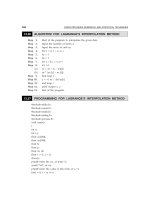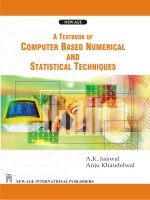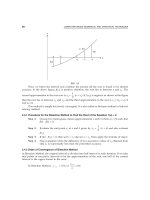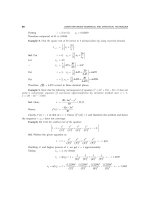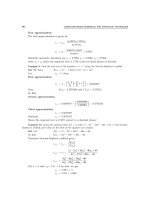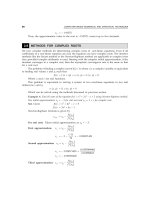A textbook of Computer Based Numerical and Statiscal Techniques part 10 ppt
Bạn đang xem bản rút gọn của tài liệu. Xem và tải ngay bản đầy đủ của tài liệu tại đây (134.27 KB, 10 trang )
76
COMPUTER BASED NUMERICAL AND STATISTICAL TECHNIQUES
First approximation:
The first approximation is given by
x
1
= x
0
–
00
0
00
sin cos
cos
xx
x
xx
+
x
1
= π –
sin cos
cos
ππ+π
ππ
= 2.8233
Similarly successive iterations are x
2
= 2.7986, x
3
= 2.7984, x
4
= 2.7984.
Since x
3
= x
4
hence the required root is 2.798 correct to three places of decimal.
Example 9. Find the real root of the equation x = e
–x
using the Newton-Raphson’s method.
Sol. We have f(x)= xe
x
– 1 then f ´(x) = (1 + x)e
x
Let x
0
= 1 then,
First approximation:
x
1
= 1 –
11
1
1
22
e
e
e
−
=+
= 0.6839397
Now, f(x
1
) = 0.3553424 and f ′(x
1
) = 3.337012
So that,
Second approximation:
x
2
= 0.6839397 –
0.3553424
3.337012
= 0.5774545
Third approximation:
x
3
= 0.5672297
Similarly, x
4
= 0.5671433
Hence the required root is 0.5671 correct to 4 decimal places.’
Example 10. Using the starting value 2(1 + i), solve x
4
– 5x
3
– 20x
2
– 40x + 60 = 0 by Newton-
Raphson’s method given that all the roots of the equation are complex.
Sol. Let f(x)= x
4
– 5x
3
+ 20x
2
– 40x + 60
So that f´(x)= 4x
3
– 15x
2
+ 40x – 40
Therefore Newton-Raphson method gives,
x
n+1
= x
n
–
()
()
n
n
fx
fx
′
x
n+1
= x
n
–
43 2
32
5204060
4154040
nnnn
nnn
xxxx
xxx
−+ − +
−+−
x
n+1
=
−+−
−+−
432
32
31020
60
415404
0
nnn
nnn
xxx
xxx
Put n = 0, take x
0
= 2 (1 + i) by trial, we get
x
1
= 1.92(1 + i)
x
2
= 1.915 + 1.908i
ALGEBRAIC AND TRANSCENDENTAL EQUATION
77
Since, imaginary roots occur in conjugate pairs roots are 1.915 ± 1.908i upto 3 places of
decimal. Assuming other pair of roots to be α ± iβ, then
Sum =
1.915 1.908
1.915 1.908
α+ β+α− β
++
+−
ii
i
i
= 2α + 3.83 = 5
⇒α= 0.585
Also, products of roots are (α
2
+ β
2
) [(1.915)
2
+ (1.908)
2
] = 60
⇒β= 2.805
Hence other two roots are 0.585 ± 2.805i.
Example 11. Apply Newton’s formula to prove that the recurrence formula for finding the nth roots
of a is x
i+1
=
()
−
−+
n
i
1
n
i
n1x a
nx
Hence, evaluate (240)
1/5
.
Sol. Let x = a
1/n
⇒ x
n
= a or x
n
– a = 0
Let f(x)= x
n
– a = 0
⇒ f´(x) = nx
n–1
.
Now, by Newtons’s-Raphson method, we have
x
i+1
= x
i
–
()
()
i
i
fx
fx
′
or x
i +1
=
()
1
1
n
i
n
i
nxa
nx
−
−+
(1)
Now to find the value of (240)
1/5
We know that (243)
1/5
= (3
5
)
1/5
= 3
Take a = 240 and n = 5 we get
x
i+1
=
5
4
424
0
5
i
i
x
x
+
(2)
First approximation:
Let i = 0, x
i
= x
0
= 2.9 (say), then from above equation (2), we get
x
1
=
()
()
5
5
0
44
0
4 2.9 240
4 240
5
52.9
x
x
+
+
=
=
()
4 205.111 240
1060.444
2.99
5 70.7281 353.6403
+
==
×
Second approximation:
Let i = 1, x
i
= x
1
= 2.99 (say), then from above equation (2), we get
x
2
=
()
()
++
=
5
5
1
44
1
424042.9924
0
5
52.99
x
x
78
COMPUTER BASED NUMERICAL AND STATISTICAL TECHNIQUES
=
()
4 238.977 24
0
399.627
+
= 2.9925
Hence, the required value of (240)
1/5
correct to three places of decimal is 2.993.
Example 12. Determine the value of p and q so that rate of convergence of the iterative method
x
n +1
= px
n
+ q
2
n
N
x
for computing N
1/3
becomes as high as possible.
Sol. We have x
3
= N therefore f(x) = x
3
– N.
Let α be the exact root, we have α
3
= N.
Substituting x
n
= α + e
n
, x
n + 1
= α + e
n+1
, N = α
3
in x
n+1
= px
n
+ q
2
n
N
x
, we have
α + e
n+1
= p(α + e
n
) + q
()
3
2
n
ae
α
+
= p (α + e
n
) + q
3
2
2
1
α
α+
α
n
e
= p(α + e
n
) + qα
2
1
n
e
−
+
α
= p(α + e
n
) + qα
2
12 3 .
nn
ee
−+ −
αα
= p(α + e
n
) + qα – 2qe
n
+ 3q
2
α
n
e
–
⇒ e
n+1
= (p + q – 1) α + (p – 2q) e
n
+ 0 (e
n
)
2
+
Now for the method to become of order as high as possible i.e., of order 2, we must have
p + q = 1 and p – 2q = 0 so that p = 2/3 and q = 1/3.
PROBLEM SET 2.4
1. Use Newton-Raphson method to find a root of the equation x
3
– 3x – 5 = 0.
(U.P.T.U. 2005) [Ans. 2.279]
2. Find the four places of decimal, the smallest root of the equation e
–x
= sin x. [Ans. 0.5885]
3. Find the cube root of 10. [Ans. 2.15466]
4. Show that the square roots of N = AB is given by
4
S
N
N
S
≈+
, where S = A + B.
5. Use Newton-Raphson method to obtain a root, correct to three decimal places of following
equations:
(a) sin x =
2
x
[Ans. 1.896]
(b) x + log x = 2 [Ans. 1.756]
(c) tan x = x [Ans. 4.4934]
ALGEBRAIC AND TRANSCENDENTAL EQUATION
79
6. Using N–R method, obtain formula for
N
and find
2
0
correct to two decimal places.
[Ans. 4.47]
7. Find cube root of 3 correct to three decimal places by Newton’s iterative method.
[Ans. 1.442]
8. Find the positive root of the equation ex = 1 + x +
2
3
2!
3!
x
x
+
e
0.3x
correct to 6 decimal places.
[Ans. 2.363376]
9. Apply Newton’s formula to find the values of (30)
1/5
.[Ans. 1.973]
10. Prove the Chebyshev formula x
1
= x
0
–
()
()
() ()
()
2
00
0
3
0
0
.
1
.
'2
fx f x
fx
fx
fx
′′
−
′
for the roots of the
equation f(x) = 0.
2.8 SECANT METHOD
The Secant method is similar to the Regula-Falsi method, except for the fact that we drop the
condition that f(x) should have opposite signs at the two points used to generate the next
approximation. Instead, we always retain the last two points to generate the next. Thus, if
1
n
x
−
and
n
x
are two approximations to the root, then the next approximation
1
n
x
+
to root is given
by
−
+
−
−
=− =
−
1
1
1
()
( ), 1, 2, 3,
() ( )
nn
nn n
nn
xx
xx fxn
fx fx
(1)
Geometrically, in Secant method we replace the function
(
)
f
x
by a straight line passing
through the points
(,())
nn
xfx
and (
11
,( ))
−−nn
xfx
and take the point of intersection of the straight
line with the x-axis as the next approximation to the root. In contrast to the Regula-Falsi method,
the Secant iteration does not bracket the root and it is not even necessary to bracket the root to
start the iteration. Hence, it is obvious that the iteration may not always coverage on the other
hand, it generally converges faster. Thus, by dropping the necessity of bracketing the root, we
improve the rate of convergence, however, in some cases, the iteration may not converge at all.
2.8.1 Procedure for Secant Method to Find the Root of
=() 0fx
Step 1: Choose the interval
[]
01
,
xx
in which
()
0
fx=
has a root, where
1
0
xx
> .
Step 2: Find the next approximation
2
x
of the required root using the formula
10
21 1
10
()
(
)
() ()
xx
x
xfx
fx fx
−
=−
−
.
Step 3: Find the successive approximations of the required root using the formula
−
+
−
−
=ε − =
−
1
1
1
()
( ), 1, 2, 3,
() ( )
nn
nn n
nn
xx
xfxn
fx fx
Step 4: Stop the process when the prescribed accuracy is obtained.
80
COMPUTER BASED NUMERICAL AND STATISTICAL TECHNIQUES
2.8.2 Rate or Order of Convergence of Secant Method
On substituting
îå=+
nn
x
, etc. in (1) we obtain the error equation as
åå îå
åå
îå îå
−
+
−
−+
=−
+−+
1
1
1
()()
()( )
nn
f
ff
nn n
nn
(2)
On expanding
+(îå)
n
f
and
−
+
1
(
îå )
n
f
in Taylor’s series about the point
î
in (2), and
using
ξ()f = 0, we obtain
1
2
1
1
22
1
1
( ) () ()
2
1
( ) () ( ) ()
2
n
nn n n
nn
nnn
ff
ff
−
−
+
−
′′′
ε−ε ε ξ+ ε ξ+
ε=ε−
′′′
ε−ε ξ+ ε−ε ξ+
On simplifying, and neglecting higher powers of
n
ε , we get
1
1
nnn
c
+
−
ε=εε
(3)
where,
()
1
2()
f
c
f
′′
ξ
=
′
ξ
Now, we seek a relation of the form
1
p
nn
k
+
ε=ε
(4)
where constants k and p are to be determined.
We have from equation (4),
1
p
nn
k
−
ε=ε or
1/ 1/
1
pp
nn
k
−
−
ε= ε
(5)
Substituting
1n+
ε
from (4), and
1n−
ε
from (5), into the error equation (3), we get
(1 )/ (1 )/ppppp
nn
ck
−+ +
ε= ε
(6)
On comparing the powers of
n
ε , we have
1 p
p
p
+
=
or p
2
– p – 1 = 0
Roots of above equation are
15
2
+
and
15
2
−
. Taking, p =
15
2
+
= 1.618 and neglecting
the other, we obtain from equation (4), the rate of convergence for the Secant method as p = 1.618.
The constant k is determined from (6), and it is given by k = c
p/(p+1)
.
The convergence of the secant method is superlinear
The purpose of this document is to show the following theorem:
Theorem 2.1: Let
{}
k
k
x
∞
be the sequence produced by the secant method. Assume the sequence
converges to a root of f (x) = 0, i.e., x
k
→
x
∞
,
()0fx
∞
=
.
Moreover, assume the root
x
∞
is regular:
'( ) 0fx
∞
≠ . Denote the error in the kth step by E
k
= x
k
–
x
∞
. Under these assumptions, we have
/2
(1 5 ) 1.618
1
kk k
ECE CE
+
+
≈≈
, for some constant C. (1)
The theorem is implied by three lemmas.
ALGEBRAIC AND TRANSCENDENTAL EQUATION
81
Lemma 2.1: Under the assumptions and notations of the theorem:
∞
+
−
∞
′′
≈
′
1
1
()
1
2()
kkk
fx
EEE
fx
. (2)
Proof. Using the definition of x
k+1
, we find
−
∞∞
++
−
−
=−=− −
−
1
11
1
()
() ( )
kk
kk kk
kk
xx
Exxxfx x
fx fx
. (3)
We can replace x
k + 1
by x
k
+ E
k
and x
k
by x
k – 1
+ E
k – 1
, so that
∞∞−
∞∞ ∞+
∞∞
−
+−−
=+− + −
+− +
1
1
1
()
()( )
kk
kkk
kk
xExE
ExEfxE x
fx E fx E
. (4)
To simplify this expression, we apply the Taylor expansion of f
()
k
xE
∞
+ and
1
(
)
k
fx E
∞−
+
about
x
∞
:
23
1
( ) () () () ()
2
kkkk
fx E fx f x E f x E OE
∞∞∞ ∞
′′′
+= + + +
, (5)
23
1111
1
( ) () () () ( )
2
kkkk
fx E fx f x E f x E OE
∞∞∞∞
−−−−
′′′
+=+ + +
. (6)
Subtracting
1
(
)
k
fx E
∞−
+ from
(
)
k
fx E
∞
+ :
∞
∞∞ ∞−− − − −
′′′
+−+= −+ −+ −
22 3 3
11 1 1 1
1
()()()()()()()()
2
kk kk kkkk
fx E fx E f x E E f x E E OE OE
(7)
Since
33
1
() (
)
kk
O
EOE
−
−
is of a smaller order than E
k
and E
k–1
we omit this term. Using
22
1−
−
kk
EE
= (E
k
– E
k–1
) (E
k
+ E
k–1
), we organize the above expression as
∞∞ ∞∞
−− −
′′′
+− + ≈− + +
11 1
()( )( )(()()( )
k k kk kk
fx E fx E E E f x f x E E
. (8)
The left of (8) appears at the right of (4), we derive the following expression:
−
∞+
∞∞−−
−
≈−+
′′′
−++
1
1
11
()
( )( ( ) ( )( ))
kk
kk k
kk kk
EE
EEfxE
EE fx fxEE
. (9)
Using a Taylor expansion for
(
)
k
fx E
∞
+ about
x
∞
(recall
()
0)
fx
∞
= we have
∞∞
+
∞∞
−
′′′
+
≈−
′′′
++
1
1
1
() ()
2
.
1
() ()( )
2
k
kkk
kk
fx f x E
EEE
fx f x E E
(10)
Now we put everything on the same denominator:
∞∞ ∞∞−
+
∞∞−
′′′ ′′′
++−−
≈
′′′
++
1
1
1
11
() ()( ) () ()
22
1
() ()( )
2
kk k
kk
kk
fx fx E E fx f x E
EE
fx fx E E
. (11)
which can be simplified as
∞−
+
∞∞−
′′
≈
′′′
++
1
1
1
1
()
2
1
() ()( )
2
k
kk
kk
fxE
EE
fx f x E E
(12)
82
COMPUTER BASED NUMERICAL AND STATISTICAL TECHNIQUES
Because
0
k
E
→ as
∞−
′′
→∞ +
1
1
,()( )
2
kk
kfxEE
is negligible compared to
(
)
fx
∞
′
, so we omit
the second term in the denominator, to find the estimate
∞
+−
∞
′′
≈
′
11
()
1
2()
kkk
fx
EEE
fx
. (13)
Lemma 2.2: There exists a positive real number r such that:
11/
11
,
rr
kkk k
k
E
CE E E KE
+
+−
≈ ⇒≈ for some constants C and K. (14)
Proof. Assuming the convergence rate is r, there exists some constant A, so we can write
1
r
k
k
E
A
E
+
≈
and
1
r
kk
E
AE
−
≈
or
−
≈
1/
1
1
.
r
kk
EE
A
(15)
Now we can replace the expressions for E
k
and E
k–1
in the left hand side of (14):
+
+
≈≈
1/
1/ 1 1/
1
1
.
r
r
r
kkkk
E
CEEBE
A
(16)
Together with the assumption that
1
,
r
k
k
E
AE
+
≈
we obtain
11/r
r
k
k
A
EE
B
+
≈
. So, we set
A
K
B
=
and the lemma is proven.
[[
[[
[
Q.E.D.Q.E.D.
Q.E.D.Q.E.D.
Q.E.D.
]]
]]
]
Lemma 2.3: For the r of Lemma 2.1, we have
+
+
≈ ⇒=
11/
1
5
.
2
rr
kk
E
CE r
(17)
Proof. r satisfies the following equation:
+=⇒+= ⇒ −−=
22
1
11 10.
rr r nr
r
(18)
The roots of n
2
– r – 1 =0 are r =
1
5
2
±
. We take the positive value for r.
The constant r =
15
1.618 is the g ol den rat
io.
2
+
≈
Example 1. A real root of the equation f(x) = x
3
– 5x + 1 = 0 lies in the interval (0.1). Perform
four iterations of the Secant method.
Sol. We have x
0
= 0, x
1
= 1, f(x
0
) = 1, f(x
1
) = – 3
By Secant method.
First approximation:
First approximation is given by
x
2
= x
1
–
()
()
10
10
xx
fx fx
−
−
f(x
1
) = 0.25
f(x
2
) = – 0.234375
ALGEBRAIC AND TRANSCENDENTAL EQUATION
83
Second approximation:
Second approximation is given by
x
3
= x
2
–
() ()
21
21
xx
fx fx
−
−
f(x
2
) = 0.186441
f(x
3
) = 0.074276
Third approximation:
Third approximation is given by
x
4
= x
3
–
()
()
32
32
xx
fx fx
−
−
f(x
3
) = 0.201736
f(x
4
) = – 0.000470
Fourth approximation:
Fourth approximation is given by
x
5
= x
4
–
()
()
43
43
xx
fx fx
−
−
f(x
4
) = 0.201640
Example 2. Compute root of the equation x
2
e
–x/2
= 1 in the interval [0.2] using Secant method. The
root should be correct to three decimal places.
Sol. We have, x
0
= 1.42, x
1
= 1.43, f(x
0
) = – 0.0086, f(x
1
) = 0.00034
By Secant method,
First approximation:
First approximation is given by
x
2
= x
1
–
()
()
10
10
xx
fx fx
−
−
f(x
1
)
x
2
= 1.43 –
1.43 1.42
0.00034 0.0086
−
+
(0.00034) = 1.4296
f(x
2
) = – 0.000011
Second approximation: Second approximation is given by
x
3
= x
2
–
() ()
21
21
xx
fx fx
−
−
f(x
2
)
x
3
= 1.4296 –
1.4296 1.42
0.000011 0.00034
−
−−
(–0.000011) = 1.4292
Since x
2
and x
3
agree up to three decimal places hence the required root is 1.429.
Example 3. Find the root of the equation x
3
– 5x
2
– 17x + 20 = 0 by Secant method.
Sol. Taking initial approximations as, x
0
= 0, x
1
= 1 and f(x
0
) = 20, f(x
1
) = – 1, then by Secant
method the next approximation is given by
x
2
= x
1
–
()
()
10
10
xx
fx fx
−
−
f(x
1
)
84
COMPUTER BASED NUMERICAL AND STATISTICAL TECHNIQUES
x
2
= 1 –
10
120
−
−−
(–1) = 1 – 0.04762 = 0.95238
Hence, f(x
2
) = 0.13824
Now the next approximation can be obtained by using x
1
and x
2
in Secant method.
Similarly, other approximations can be obtained by using two recent approximations in
Secant method.
These are x
3
= 0.95816, f(x
3
) = 0.00059
x
4
= 0.95818, f(x
3
) = 0.00011
x
5
= 0.95818.
Thus the approximate root can be taken as 0.65818, which is correct up to five decimals.
Example 4. Find the root of the equation x
3
– 2x – 5 by Regula-Falsi and Secant method.
Sol. Solution by Regula-Falsi method:
Here f(x)= x
3
– 2x – 5 then f(2) = – 1, f(3) = 16 and f(2) f(3) < 0
Therefore initial approximations are taken as x
0
= 2, x
1
= 3 and f (x
0
) = – 1, f (x
1
) = 16
Then by Regula-Falsi method the next approximation is given by
x
2
= x
1
–
()
()
10
10
xx
fx fx
−
−
f(x
1
)
x
2
= 3 –
()
()
32
16
1
−
+
16 = 3 – 0.9412
x
2
= 2.0588
Hence, f(x
2
) = – 0.3911 and f(x
1
) f (x
2
) < 0, therefore the next approximation to the root is
obtained by using the values of x
1
and x
2
in Regula-Falsi method as
x
3
= x
2
–
() ()
21
21
xx
fx fx
−
−
f (x
1
)
x
3
= 2.0588 –
()
()
2.0588 3
0.3911 1
6
−
−−
(–0.3911) = 2.0588 + 0.0225
x
3
= 2.0813
Hence, f(x
3
) = – 0.1468 and f(x
1
) f (x
3
) < 0, therefore the next approximation is obtained by
using the values of x
1
and x
3
in Regula-Falsi method.
Proceed in similar way to obtain the iterations as follows
x
4
= 2.0899, f(x
4
)< 0
x
5
= 2.0928, f(x
5
)< 0
x
6
= 2.0939, f(x
6
)< 0
x
7
= 2.0943, f(x
7
)< 0
x
8
= 2.0945, f(x
8
)< 0
x
9
= 2.0945.
Thus, the root can be taken as 2.0945 correct up to four decimals.
ALGEBRAIC AND TRANSCENDENTAL EQUATION
85
Solution by Secant method: Taking initial approximations as x
0
= 2, x
1
= 3 and
f(x
0
) = –1, f(x
1
) = 16, then by Secant method, the next approximation is given by
x
2
= x
1
–
()
()
()
()
10 1
10
xxfx
fx fx
−
−
x
2
= 3 –
()
()
−
+
32
16
1
16 = 3 – 0.9412
Hence, x
2
= 2.0588, f(x
2
) = – 0.3911
Now, the next approximation can be obtained by using the values of x
1
and x
2
in Secant
method. Similarly, other approximations can be obtained by using two recent values of
approximations. These are
x
3
= 2.0813, f(x
3
) = – 0.1468
x
4
= 2.0948, f(x
4
) = – 0.0028
x
5
= 2.0945, f(x
5
) = – 0.0006
x
6
= 2.0945.
Thus, the root can be taken as 2.0945 correct to four decimals.
Example 5. Find the root of the equation f(x) = 4 sin x + x
2
= 0 by Secant method.
Sol. In this method we neglect the condition f(x
n
) f(x
n−1
) < 0. Initially, take x
0
= – 1, x
1
= –
2 and f(x
0
) = – 2.36588, f(x
1
) = 0.36281, the next approximation to the root by Secant method is
given by
x
2
= x
1
–
()
()
()
()
10 1
10
xxfx
fx fx
−
−
x
2
= (–2) –
()
()
2 1 0.36281
0.36281 2.36588
−+
+
x
2
= – 2 + 0.13296 = – 1.86704
Hence, x
2
= – 1.86704, f(x
2
) = – 0.33992
Now, the next approximation x
3
can be obtained by using the values of x
1
and x
2
in Secant
method, which is given by,
x
3
= x
2
–
()
()
() ()
21 2
21
xxfx
fx fx
−
−
x
3
= (–1.86704) –
()
()
1.86704 2 0.3399
2
0.33992 0.36281
−+−
−−
x
3
= – 1.86704 – 0.06431 = – 1.93135
Hence, x
3
= – 1.93135, f(x
3
) = – 0.01269
Now, the next approximation x
4
can be obtained by using the values of x
2
and x
3
in Secant
method. Continuing this process and using two recent approximations, to get next approximation,
in Secant method, we get
x
4
= – 1.93384, f(x
4
) = 0.00045
x
5
= – 1.93375, f(x
5
) = – 0.00002
